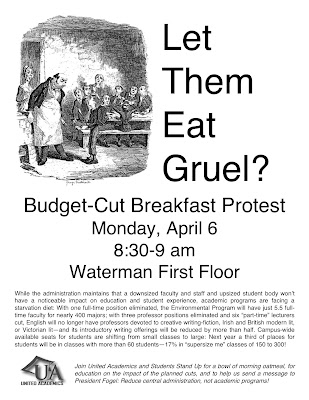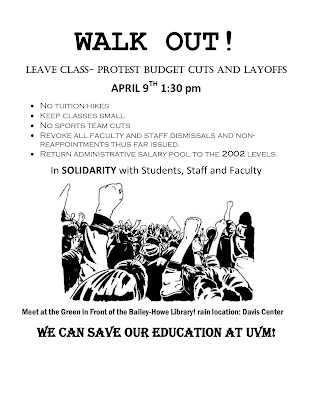Thanks to bronwynvt for alerting me to the below article from Business Week that adds to our "Tap the endowment" argument.
Some background: Under President Fogel, UVM has aspired to follow the example of the country's elite private colleges that fund big portions of their operations through investment revenues from massive, multi-billion-dollar endowments. In the below Business Week article, however, the elite university model is called into question. Instead of hoarding a university's resources in endowments, the article's author argues, a university should put gift money to work right away for benefit of students and to meet a university's current needs. What does this mean for UVM?
* We would be better off following the example of other public universities, such as Cal State Long Beach mentioned below, than trying to model ourselves after elite private universities whose addiction to the financial markets has led to greater financial crunch and instability than public institutions are experiencing. (Consider: Middlebury and Dartmouth are laying off faculty and staff; SUNY, UNH, and UMass/Amherst have announced no layoffs.)
* Far from being financially prudent for UVM to be protecting what's left of its endowment (some $200 million) now, it is imprudent not to use as much of this money as possible to stave off further tuition and fee hikes and safeguard student experience so UVM has students who can enroll here, graduate, and very possibly go on to be grateful alums who give back to the university.
TOP NEWS March 1, 2009, 6:49PM EST
Academic Endowments: The Curse of Hoarded Treasure
Universities are cutting budgets and shortchanging today's students to risk what's left of their endowments in financial markets
By Peter Coy
Something seems wrong with the way elite U.S. universities finance themselves. The problem: They're addicted to multibillion-dollar endowments. When the endowments suddenly shrink, they can seem more like curses than blessings. Harvard University, the richest institution of higher education on the planet, gets about one-third of operating funds from its endowment.
Now that Harvard is expecting a roughly $11 billion endowment decline over the current academic year—30% of the total—the university is in such a financial squeeze that it has frozen faculty salaries and offered early retirement to 1,600 employees. Princeton is even more addicted to its endowment, which provides about 45% of its operating budget. Princeton Provost Christopher Eisgruber warned in February: "We are beginning to live in the 'new normal' and we should not expect to go back to how we operated in the last 10 years."
Is there a better way? There could be. Here's an idea: Maybe rich universities should act more like companies, which somehow manage to operate without endowments. Universities could raise just as much money from wealthy alumni and other donors as they do now, but they wouldn't hoard it in a great big piggy bank. They'd spend it as it came in, the way companies spend their revenue on current needs.
WHY MUST UNIVERSITIES HOARD MONEY?
Most universities that aren't super-wealthy already do behave like companies because they have little choice: They don't pile up endowments because they have urgent current needs for the money. Take California State University at Long Beach, where about a third of undergraduates are first-generation college students. The school does raise money from alumni and other sources, but it puts most of the proceeds to use right away for such purposes as scholarships. In a Feb. 27 interview, President F. King Alexander said: "Our students need that money. We're not wealthy enough to sock it away when we have so many needs on our campus right now."
Any ordinary company that followed the money-hoarding strategy embraced by such institutions as Harvard, Princeton, Yale, and Stanford would soon receive an inquisitive letter from the likes of raider Carl Icahn, who would want the CEO to explain why he or she couldn't find anything more useful to do with the money than stash it away. It's a fair question, both for companies and for universities.
The most frequent argument for having a big endowment is that it's supposed to tide schools over tough times. It sure isn't working out that way. True endowment funds can't be spent even in an emergency; only the cash income and capital gains from them can be spent. (Does anyone remember what capital gains are these days?) So-called quasi-endowment funds can be drawn down if necessary, but universities seem loath to do so even in the current circumstances, as if preserving capital is a higher priority than preserving academic programs.
BIG ENDOWMENTS FLOW TO RISKY MARKETS
Harvard compounded its problems by investing in exotic assets that it can't now sell at any reasonable price, but other schools are down as well. Between July 1 and Nov. 30 last year, endowments at 435 surveyed schools lost 23% of their value, according to the National Association of College and University Business Officers.
Sure, the bad economy is also walloping universities that don't have endowments, as strapped donors cut back. But a big endowment tends to tie a university's fortunes closely—probably too closely—to the vagaries of the financial markets. In 2007, when markets were still flying high and schools were loaded, BusinessWeek printed an eye-opening article called "The Dangerous Wealth of the Ivy League."
Writer Anthony Bianco cited examples of lavish spending on facilities such as Whitman College, a student residence at Princeton University funded by former eBay (EBAY) CEO (and Princeton alum) Meg Whitman. Each student room has triple-glazed mahogany casement windows made of leaded glass, Bianco wrote. The dining hall boasts a 35-foot ceiling gabled in oak and a "state of the art servery." The Ivies, along with Stanford University and other well-heeled schools, were able to snatch top faculty from public universities, creating a brain drain and engendering ill will. Now, of course, they're back to watching pennies—a wrenching change.
THE SYSTEM FAVORS FUTURE STUDENTS
By force of circumstance, some richer schools may be coming around to the virtues of spending the money as it comes in instead of socking it away. They have always solicited donations for the "general fund," but this could become a higher priority. Cornell University President David Skorton, at a lunch meeting with reporters on Feb. 27, said that when he tried to hit up one generous graduate recently for $1 million to endow a scholarship, the alum said that all he could commit to was giving $50,000 per year for the next four years. That's equal to the income that $1 million would throw off at a 5% return. Not a bad alternative to an endowment gift, really, especially if it's renewed.
Yale Law Professor Henry Hansmann anticipated the current questioning of endowments nearly 20 years ago in an article called "Why Do Universities Have Endowments?" that appeared in the January 1990 issue of the Journal of Legal Studies. The article runs through 14 justifications for endowments and raises questions about all of them. For example, it's often said that endowments help future generations of students, and that's true. But Hansmann points out that by saving donations rather than spending them now, universities are giving advantages to future students at the expense of current ones.
If we assume that living standards continue to rise, that amounts to taking from the poor to give to the rich. Hansmann is also skeptical of the idea that universities need to smooth out their spending by putting the occasional, very large gift into the endowment fund rather than spending it all at once. He writes that while it might make sense to bank a big gift and spend it over a multi-year period, there's no need to book it as permanent, untouchable capital.
THE MISSION: SERVICE, NOT TREASURE
Human foibles may be a better explanation for the accumulation of huge endowments, Hansmann seems to conclude. On the supply side of funding, he writes, "many donors restrict their gifts for use as endowment, not to advance education and knowledge, but to purchase a bit of personal immortality."
On the demand side, boards of trustees may solicit funds for endowment rather than current spending simply because they like the idea of presiding over a big pile of money: "It may be that, consciously or unconsciously," he writes, "university trustees tend to focus on the size of the university's retained earnings (that is, its endowment) as a measure of the success of the management of the institution." That amounts to collecting money for money's sake. Adds Hansmann: "One sometimes has the sense that universities compete among themselves to have the largest endowment."
Memo to the board of trustees: You're supposed to be running a service business here, not piling up treasure.
Coy is BusinessWeek's Economics editor.



